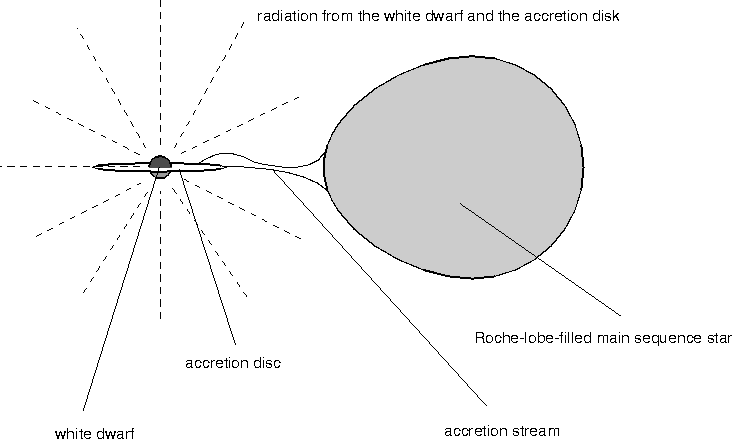
Kinwah Wu and Dayal Wickramasinghe have suggested that AM Herculis systems, which were previously thought to be the most strongly braked class of cataclysmic variables, may in fact be the most weakly braked.
Cataclysmic variables (CVs) are a specific class of binary systems consisting of a white dwarf and an ordinary star. The two stars in a CV orbit each other in a period of less than one day. The ordinary star is relatively cool and has a mass of a fifth to a half the mass of the Sun, is classified as an M dwarf star. In a rotating binary system there is an enclosed region around each star, called the Roche lobe, within which matter is gravitationally bound to the star. The size of the Roche lobes depends on the separation between the stars; stars that are close together have small Roche lobes. In CVs the separation between the stars is so small that the M dwarf fills its Roche lobe, and matter spills over onto the white dwarf. As the accreting matter falls onto the white dwarf, it forms a disk around the star, called an `accretion disk'. The infalling matter releases its gravitational energy, heating the accretion disk and the regions where matter falls onto the white dwarf. As a result, radiation is emitted in the infrared to X-ray bands. These systems are called `cataclysmic variables' because of the large fluctuations in this emitted radiation.
There are two classes of CVs for which magnetic effects are important. In AM Herculis systems, named after the first of this type of system to be discovered, the magnetic field of the white dwarf is strong enough to lock the rotation of the two stars together. The stars then rotate synchronously, so that the orbital period of the binary and the spin periods of the two stars are all equal. In other words, each star rotates once about its own axis in the same time as it takes to complete one orbit about its companion. In these systems the magnetic field also funnels the accreting matter onto the white dwarf preventing the formation of an accretion disk. The other class in which magnetic fields are important includes the so called intermediate polars and the DQ Herculis systems, which have weaker magnetic fields than the AM Herculis systems. These systems are asynchronously rotating; although the spin period of the M star is still equal to the orbital period, the spin period of the white dwarf is shorter. CVs of this class have an accretion disk but the magnetic field of the white dwarf prevents the inner edge of the accretion disk reaching the surface of the white dwarf. Material from the inner edge of the accretion disk is guided along the magnetic field lines and dumped near the magnetic poles of the white dwarf.

: Schematic of a cataclysmic variable system.
Most of the radiation is emitted from the inner region of
the accretion disk and from hot spots on the white dwarf.
In all CVs the separation between the two stars decreases and their orbital periods become shorter. At least two processes are responsible for this phenomenon. One is called magnetic braking, and is due to a wind from the M dwarf carrying matter away to large distances away from the binary system. The other process is gravitational radiation, which is the dominant braking mechanism for very short orbital periods (less than about three hours).
There has been controversy over whether or not these two classes are closely related with similar evolutionary trends. Kinwah Wu and Professor Dayal Wickramasinghe (Australian National University) have investigated the relative populations and the evolution of these two classes by computer simulations using a Monte Carlo technique. They concluded that these two classes probably evolve quite differently.
Magnetic braking in synchronously rotating CVs has been investigated by Kinwah Wu, Jianke Li and Dayal Wickramasinghe. They showed that magnetic braking is less efficient than had previously been thought. An implication is that, whereas AM Herculis systems were thought to be the most strongly braked CVs, they now appear to be the most weakly braked CVs. This result is consistent with the simulation study of the evolution of AM Herculis binaries by Kinwah Wu and Dayal Wickramasinghe.